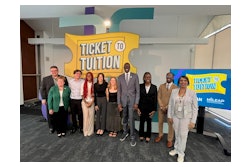 Dr. Michael Odu says colleges just can’t deal in “ethnic or surface area diversity.”
Dr. Michael Odu says colleges just can’t deal in “ethnic or surface area diversity.”AUSTIN, Texas ― As the killing of unarmed Black youth by law enforcement continues to become more common, community colleges are finding ways to combat the generationally deep divisions between minorities and the police, incorporate diversity best practices on campuses, and identify success indicators for males at the National Institute for Staff and Organizational Development (NISOD) conference.
The estimated 1,300 NISOD community college faculty, staff and administrator attendees took in sessions on social justice responses to conflict, 21st century diversity concerns and male student keys to success.
Jeffrey P. Forrest, interim dean of business and human development at St. Louis Community College, conducted the session “Crisis in Ferguson: A Community College Responds” to demonstrate what colleges can do to circumvent detrimental stigmas plaguing communities such as the events surrounding the death of Michael Brown.
He said a job fair, hosted by the St. Louis chapter of the National Urban League in partnership with St. Louis Community College’s Florissant Valley campus, sparked a renewed sense of purpose for Ferguson residents. Community listening circle sessions and skilled trade expos, among many other programs, also indicated that Florissant Valley was picking up the pieces of a broken community dating back over five decades of economic decline.
“Florissant Valley wasn’t just sitting on the sideline hoping things would get better; we were officially in the game,” said Forrest.
Ferguson, Missouri’s 63 percent African-American Florissant Valley campus of St. Louis Community College sits 2.8 miles away from where Brown was gunned down. The 700-plus residents who attend the college are seeing improvements in outcomes, but were not before the Brown incident, according to North St. Louis County native Forrest.
“When a municipality loses its job base, when it loses it families that are producing wealth, the county had to find a way to make up for that income,” said Forrest. “What do you do? Find a new revenue stream. It will come from an African-American who is driving too fast. We will ticket ourselves into solvency.
“We will create a system where African-American men will be charged exorbitant fines for routine traffic citations. Taxation by citation of everybody else. This has worked in Ferguson for 50 years.”
Other sessions highlighted community college campuses committed to ambitious goals for student success in spite of challenges among diverse student populations in the 21st century.
Dr. Michael Odu of Hillsborough Community College (HCC) in Tampa, Florida, noted that community colleges that have diversity statements on their websites tend to exist in name only but do not necessarily implement strategies to make their campuses inclusive.
“When you include diversity of thought into your curriculum, you are truly serving your students and your community,” said Odu, academic affairs faculty coordinator at HCC. “Intentionally lead faculty and administrators with thought, not just ethnic or surface area diversity.”
Beyond the classroom, administrators need to indicate commitment from the top down. “For diversity to work, it has to be part of a strategic plan for the entire college. The president needs to be committed to investing in resources for diversity programs, and employ measurable goals so the institution will be accountable. There has to be accountability from the top,” Odu said.
Male students tend to be the most vulnerable when considering academic, social and societal obstacles and are based on several factors stipulated in the session on effectively serving the male student community college population. “Critical thinking, leadership development, mental toughness and enhancing communications skills are instrumental in overcoming success challenges for male students,” said El Centro College speech communications professor Derrick Payne.
There is also distance between academic aspirations and achievement for male students of color.
“Black and Latino males have higher aspirations regarding college, but [are] less likely to obtain those goals,” Payne said.
Also originally from Ferguson, Missouri, Payne pointed out that tensions arise from male students for many reasons and community colleges need to be mindful of that.
“If a male student explodes in class or on campus, those emotions appear amplified just because they are male,” he said. “We have to build healthier communication in times of conflict. Does your campus have a place where a male student can go? Is there a space on your campus for the male student to vent frustrations? Everybody deserves humanity and respect.”
Payne added that sometimes physical and mental toughness can be confused and male students need to understand the difference.
“Ultimately it comes down to definitions of masculinity,” he said. “What does it mean to be tough? We have to do a better job of reforming and reshaping the definition of masculinity. Physical toughness has a cap on it.
“We have a penitentiary down the road that has a lot of physically tough people in it. Mentally tough people figured out that was not where they wanted to be since they were children, and have never sat in the back of a police car.”
Jamal E. Mazyck can be reached at [email protected] and on Twitter @jmbeyond7.


















